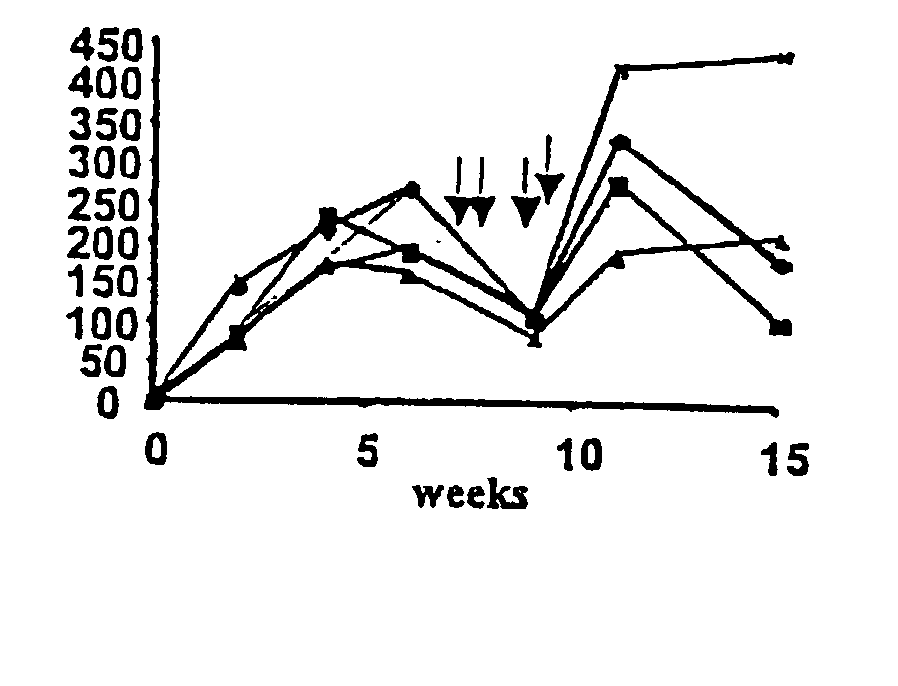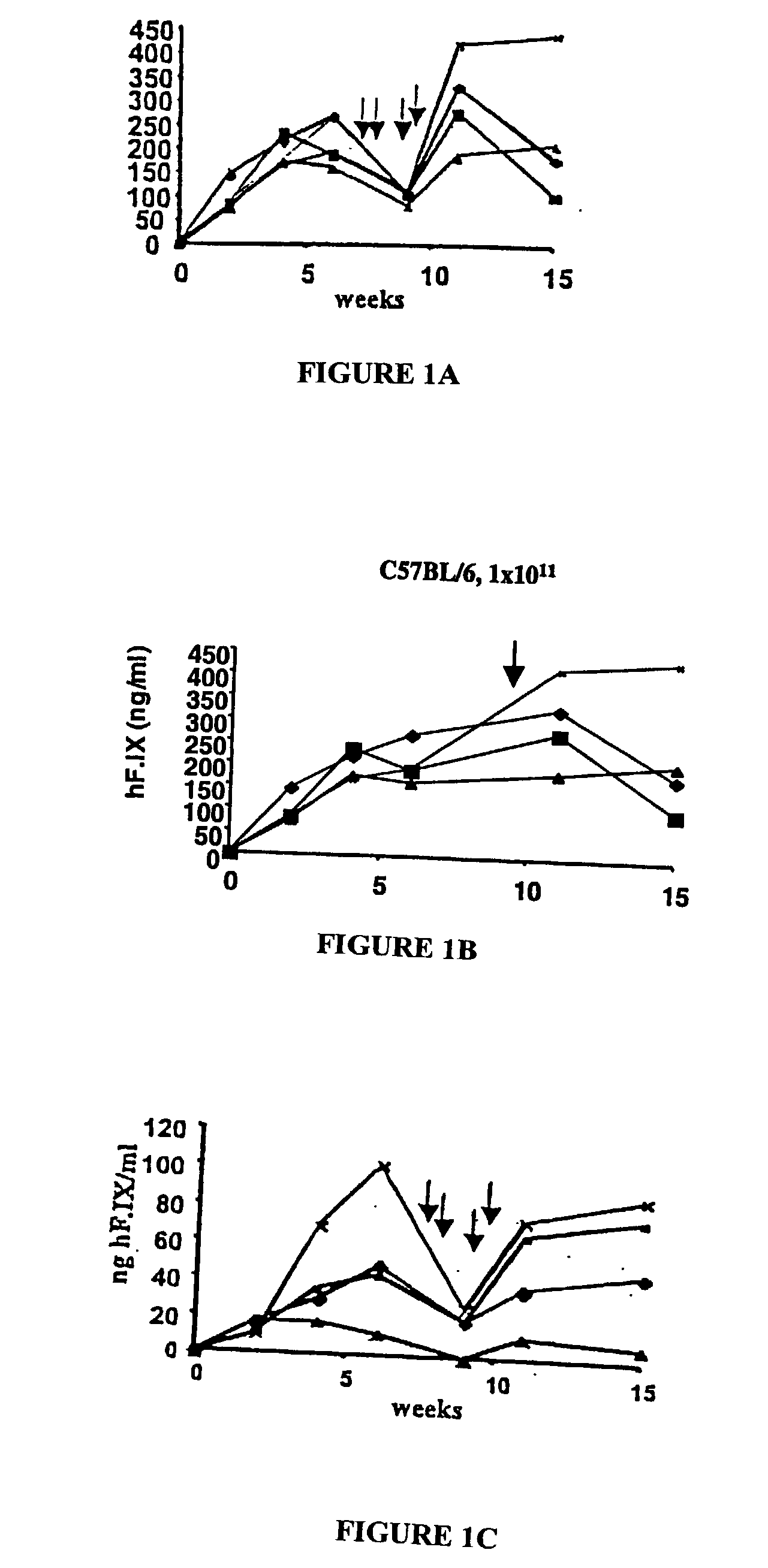Induction of tolerance to a therapeutic polypeptide
a technology of tolerance and polypeptide, which is applied in the direction of enzymes, biocide, plant growth regulators, etc., can solve the problems of replacement therapy carrying the risk of transmitting blood-borne diseases, affecting the effect of replacement therapy, and affecting the effect of gene therapy
- Summary
- Abstract
- Description
- Claims
- Application Information
AI Technical Summary
Problems solved by technology
Method used
Image
Examples
example 2
[0077] Mouse Strains Experimental Assays
[0078] Example 2.1 Mouse Strains
[0079] Hemostatically normal C57BL / 6, BALB / c, C3H, and CD-1 mice as well as .gamma..delta.-T cell receptor deficient, CD8.sup.+ T cell deficient, IL-4 deficient, and Fas-deficient mice (all on a C57BL / 6 genetic background) were purchased from Jackson Laboratory. AAV vector (25 .mu.l per injection) was delivered into the portal vein via splenic capsule injection with a Hamilton syringe following a ventral midline incision as described (Nakai et al., Blood (1998) 91:4600 and Mingozzi et al., J. Virol. (2002) 76 in press). For hemostatically normal mice, this procedure could be carried out as published. Hemophilia B mice without endogenous F.IX expression (due to a targeted deletion of the promoter and the first 3 exons of the F.IX gene (Lin et al., Blood (1997) 90:3962) received pooled normal mouse plasma (200 .mu.l) by tail vein injection <30 min prior and after surgery. These mice were generated by repeated bree...
example 3
[0084] Sustained hF.IX expression following AAV-EFl.alpha.-hF.IX or AAV-ApoE / hAAT-hF.IX administration in mice
[0085] Example 3.1
[0086] Two vectors, AAV-EFl.alpha.-hF.IX and AAV-ApoE / hAAT-hF.IX, were produced for expression of hF.IX from the ubiquitous EFl.alpha. promoter or a hepatocyte-specific ApoE enhancer / human .alpha.1-anti-trypsin promoter combination. These vectors were infused into the portal circulation via the spleen for efficient gene transfer to the liver. Recipients of gene transfer were male immunocompetent mice of three different inbred strains with defined MHC haplotypes: C57BL / 6 (H-2.sup.b), BALB / c (H-2.sup.d), and C3H (H-2.sup.k). All strains form neutralizing anti-hF.IX after IM administration of vector (Fields (2000) and unpublished results).
[0087] The AAV-EFl.alpha.-hF.IX vector was infused into the portal vein of C57BL / 6, BALB / c and C3H mice. Strong hF.IX expression was detected by immunofluorescence in the hepatocytes following portal vein injection (FIG. 1A a...
example 4
[0092] Sustained expression of F.IX is associated with induction of immune tolerance
[0093] Since mice of different strains showed sustained expression of the hF.IX antigen and failed to mount a neutralizing anti-hF.IX response following hepatic gene transfer, we sought to investigate the nature of this immunological unresponsiveness to the transgene product. Unresponsiveness of the immune system may be the result of ignorance, e.g. due to lack of efficient antigen-derived peptide presentation following this route of administration. If the murine immune system was simply ignoring the hF.IX antigen, an immune response should occur given the proper immunological challenge. Alternatively, transgene expression may have induced immune tolerance.
[0094] Example 4.1 AAV vector induces antigen-specific immune tolerance in mice
[0095] Each of the nave control mice (four per strain) and the mice that received liver-directed AAV-EFl.alpha.-hF.IX gene transfer were challenged with one subcutaneous...
PUM
| Property | Measurement | Unit |
|---|---|---|
| pH | aaaaa | aaaaa |
| concentration | aaaaa | aaaaa |
| time | aaaaa | aaaaa |
Abstract
Description
Claims
Application Information
 Login to View More
Login to View More - R&D
- Intellectual Property
- Life Sciences
- Materials
- Tech Scout
- Unparalleled Data Quality
- Higher Quality Content
- 60% Fewer Hallucinations
Browse by: Latest US Patents, China's latest patents, Technical Efficacy Thesaurus, Application Domain, Technology Topic, Popular Technical Reports.
© 2025 PatSnap. All rights reserved.Legal|Privacy policy|Modern Slavery Act Transparency Statement|Sitemap|About US| Contact US: help@patsnap.com



